
The Game Boy Advance (GBA) is a 32-bit handheld game console developed, manufactured and marketed by Nintendo as the successor to the Game Boy Color. It was released in Japan on March 21, 2001, in North America on June 11, 2001, in the PAL region on June 22, 2001, and in mainland China as iQue Game Boy Advance on June 8, 2004.
Mario Kart is a series of kart racing games and a spin-off Mario franchise developed and published by Nintendo. Players compete in go-kart races while using various power-up items. It features characters and courses mostly from the Mario series as well as other gaming franchises such as The Legend of Zelda, Animal Crossing, F-Zero, Excitebike, and Splatoon.

Mario Kart: Super Circuit is a 2001 kart racing game for the Game Boy Advance (GBA). It is the third Mario Kart game and retains its predecessors' gameplay: as a Mario franchise character, the player races opponents around tracks based on locales from the Super Mario platform games. Tracks contain obstacles and power-ups that respectively hamper and aid the player's progress. Super Circuit includes various single-player and multiplayer game modes, including a Grand Prix racing mode and a last man standing battle mode.

Princess Peach is a character in Nintendo's Mario franchise. She was created by Shigeru Miyamoto and introduced in the 1985 original Super Mario Bros. game as Princess Toadstool. She is the princess regnant and head of state of the Mushroom Kingdom, where she resides in her castle along with Toads. Since her debut, she has appeared in the majority of Mario video games as the main female character and the romantic interest of Mario. She has been voiced by Samantha Kelly since 2007.

Mario Tennis is a 2000 sports video game developed by Camelot Software Planning and published by Nintendo for the Nintendo 64. Following Mario's Tennis, it is the second game in the Mario Tennis series. The game is known for being the introduction of Luigi's arch-rival, Waluigi, and the re-introduction of Princess Daisy and Birdo.

Waluigi is a character in the Mario franchise. He plays the role of Luigi's arch-rival and accompanies Wario in spin-offs from the main Mario series, often for the sake of causing mischief. He was created by Camelot employee Fumihide Aoki and was voiced from 2000 to 2022 by Charles Martinet, who described Waluigi as someone with a lot of self-pity. Waluigi's design is characterised by his tall stature, thin and lanky frame, and his purple and black outfit with purple hat, which displays an inverted yellow "L".

Wario is a character in Nintendo's Mario video game series that was designed as an archnemesis to Mario. Wario first appeared as the main antagonist and final boss in the 1992 Game Boy game Super Mario Land 2: 6 Golden Coins. His name is a portmanteau of the name Mario and the Japanese word warui, meaning "bad". He is usually portrayed as a greedy treasure hunter who routinely loses the treasure or artifacts he ultimately finds. Since his debut, he has appeared in the majority of Mario video games. Hiroji Kiyotake designed Wario, and Charles Martinet voiced the character from 1993 to 2023.

Mario Golf: Toadstool Tour, known in Japan as Mario Golf: Family Tour, is a 2003 sports game developed by Camelot Software Planning and published by Nintendo for the GameCube. It is the sequel to the 1999 Nintendo 64 title Mario Golf, and is the third game in the Mario Golf series. It was released in North America on July 28, 2003, in Japan on September 5, 2003, and in PAL regions in 2004.
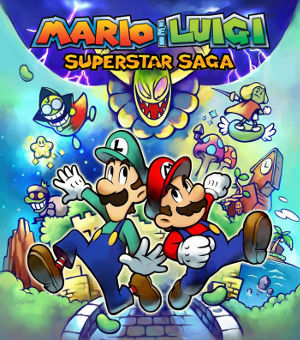
Mario & Luigi: Superstar Saga is a 2003 role-playing game developed by AlphaDream and published by Nintendo for the Game Boy Advance. It was re-released for the Wii U's Virtual Console in 2014, Nintendo Switch Online Service in 2023, and remade for the Nintendo 3DS as Mario & Luigi: Superstar Saga + Bowser's Minions in 2017. In the game, Mario and Luigi travel to the Beanbean Kingdom in order to combat Cackletta and Fawful, who stole Princess Peach's voice for the purpose of harnessing the power of a special artifact called the Beanstar.

The Nintendo e-Reader, commonly abbreviated as e-Reader, is an add-on manufactured by Nintendo for its Game Boy Advance handheld video game console. It was released in Japan in December 2001, with a North American release following in September 2002. It has an LED scanner that reads "e-Reader cards", paper cards with specially encoded data printed on them.

Mario Power Tennis is a sports game developed by Camelot Software Planning and published by Nintendo. The game is the sequel to the Nintendo 64 title Mario Tennis, and is the fourth game in the Mario Tennis series. Power Tennis was released for the GameCube in Japan and North America in late 2004, and in PAL regions in early 2005. The game was ported for the Wii in 2009 as part of the New Play Control! series, and was also re-released as a Nintendo Selects title in 2012. A companion handheld game, Mario Tennis: Power Tour, was also released on Game Boy Advance around the same time as the original GameCube release, bearing the same title as Power Tennis in Europe.
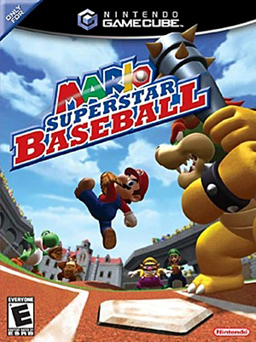
Mario Superstar Baseball is a 2005 sports video game developed by Namco and published by Nintendo for the GameCube. The game was created in the vein of other Mario sports games such as Mario Golf: Toadstool Tour and Mario Power Tennis. A sequel, Mario Super Sluggers, was released for the Wii in 2008.

Mario's Tennis is a 1995 sports game developed by Nintendo for the Virtual Boy video game console. The game was released at the launch of the Virtual Boy, and later as a pack-in game in North America.
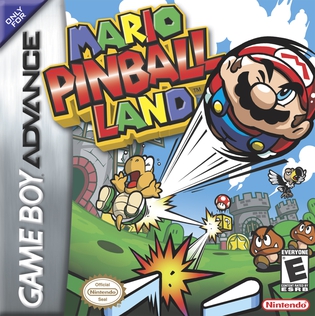
Mario Pinball Land, known in Europe and Japan as Super Mario Ball, is a pinball video game developed by Fuse Games and published by Nintendo for the Game Boy Advance, released in 2004. It is the ninth Mario game for the Game Boy Advance and is considered a spin-off into the Super Mario series of games. The game was later re-released for the Wii U Virtual Console.

Mario Golf: Advance Tour is a role-playing video game-styled sports game developed by Camelot Software Planning and published by Nintendo for the Game Boy Advance in 2004. The game is the sequel to the Game Boy Color version of Mario Golf and the Game Boy Advance counterpart of Mario Golf: Toadstool Tour.
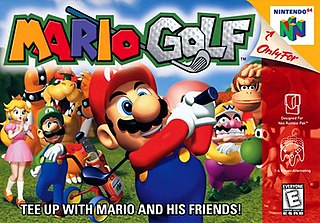
Mario Golf is a 1999 sports game developed by Camelot Software Planning and published by Nintendo for the Nintendo 64. Mario, his friends, and his enemies play golf on a variety of Mario-themed courses. Following NES Open Tournament Golf, it is the second game in the Mario Golf series. Camelot also developed a Game Boy Color version, which adds role-playing elements.

Mario is a Japanese multimedia franchise created by Japanese game designer Shigeru Miyamoto for video game company Nintendo which produces and publishes its installments. Starring the titular Italian plumber Mario, it is primarily a video game franchise, but has extended to other forms of media, including television series, comic books, a 1993 feature film, a 2023 animated film and theme park attractions. The series' first installment was 1983's Mario Bros., although Mario had made his first appearance in 1981's arcade game Donkey Kong, and had already been featured in several games of the Donkey Kong and Game & Watch series. The Mario games have been developed by a wide variety of developers including Nintendo, Hudson Soft, and AlphaDream. Mario games have been released almost exclusively for Nintendo's various video game consoles and handhelds, from the third generation onward.

Mario Tennis Open is a 2012 Mario sports game developed by Camelot Software Planning and published by Nintendo for the Nintendo 3DS. The game was developed by Camelot, the company that produced most of the previous Mario Tennis titles. The game was first released on May 20, 2012 in North America and in other regions the same month. It was later released as a downloadable title on the Nintendo eShop in late 2012 and Nintendo Selects in 2015/2016.
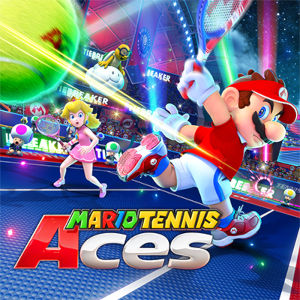
Mario Tennis Aces is a 2018 tennis game developed by Camelot Software Planning and published by Nintendo for the Nintendo Switch. The game is part of the Mario Tennis series and sold over four million copies by the end of 2021, making it one of the best-selling games on the Switch. The game received generally favorable reviews from critics.



















